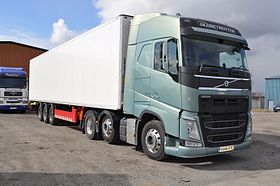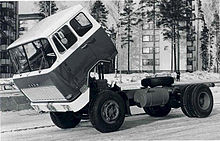Cab over
 Volvo FH cab-over | |
| Overview | |
|---|---|
| Manufacturer | Various |
| Also called | COE, forward control |
| Production | 1899–present |
| Assembly | Worldwide |
| Body and chassis | |
| Class | Light, medium, and heavy |
| Body style | Cab over engine |
Cab-over, also known as cab over engine (COE),
This truck configuration is currently common among

Cabover trucks are widely used in the United States for
Cabovers are also very popular in the US's light- and medium-duty truck segment where compact size is required for urban mobility without sacrificing payload;
History

The first truck in the United States was built by Autocar in 1899 using a format then called "engine-under-the-seat" and was available with optional 5 or 8 horsepower (3.7 or 6.0 kilowatts) motors.[1] Although early Autocar trucks were not exactly "cab-over", since the truck did not have a cab, per se, they were the fore-runners to COEs. The Sternberg company of Wisconsin produced cab-over trucks as early as 1907, though by 1914 only their seven-ton model was a cab-over. They reintroduced the cab-over layout in 1933 with their "Camel Back" model, which allowed the cab to be tilted to access the engine.[2]
The introduction of the first modern cab-over layout in the United States is credited to industrial designer
The laws of the time limited overall truck length to 42 feet (12.8 m) on highways. Setting the cab over the engine and
Autocar reintroduced the engine-under-the-seat format with their Model U in 1933, which became a staple of U.S. roads and the U.S. military through World War II and well into the 1950s.[1]
White-Freightliner introduced its first tilting cab-over design in 1958, which allowed the entire cab to tilt forward for access to the engine.[2]
Design aspects


In
In both class 8 tractors and light- and medium-duty vocational trucks, the cab-over-engine design gives the COE model an advantage in maneuverability over a conventional model. And since COEs are generally lighter than conventionals, they can often haul heavier loads, given equal
One critique is that the shorter wheelbase in the COE semi-trucks gives a rougher ride than those with conventional cabs, as the driver's seat is above the
Because of their flat front design, early COE semi-trucks had significantly worse
Although the tilting cab gives comparatively unobstructed access to the engine, its deployment causes unsecured items in the cab and sleeper (if equipped) to fall onto the
Safety aspects



Truck occupant safety depends on survival space within the cab, with "rollover" being the most significant heavy truck accident causing occupant casualties.
Motor placement before or under the cab does not have much influence on the results of rollovers. Behind the danger of a rollover, heavy truck on heavy truck crashes are the second most relevant reason for occupant casualties. With a 1980s US conventional, the result of such a crash was: Frame, front axle and wheels would go under the truck in front, while the motor got pushed into the cab (which was very small in a 1980s conventional).[7][8]
Both conventionals and cabovers need structural protection against rollovers, and special protection against massive objects at the height of another truck body. The survival space should be able to move backward on the frame.
In military use, the COE design increases the chance of crew injury or death in the event of running over a
See also
References
- ^ a b "Company". Archived from the original on 8 February 2015. Retrieved 23 August 2016.
- ^ ISBN 0-7603-0038-0.
- ^ Staff. "Metropolitan Auto and Carriage Co., Metropolitan Body Co". Retrieved 14 December 2013.
- ^ Reif, Zygmunt F.; Moore, Thomas N.; Steevensz, Arthur E. (February 1980). Noise Exposure of Truck Drivers. Vehicle Noise Regulation and Reduction Session. Detroit: Society of Automotive Engineers.
- ^ Richards Award Winning Kenworth Cabover
- ^ Herbst, Brian R.; Forrest, Stephen M.; Meyer, Steven E.; Clarke, Christopher C.; Bell, Lauren D.; Oliver Nelson, Arin (2015). Test Methods for Occupant Safety in Heavy Truck Rollovers (PDF). RCOBI Conference. Retrieved 7 November 2017.
- ^ "Castro Valley: Lanes reopen after big-rig fatal wreck blocks I-580 for hours". East Bay Times. US. 14 September 2017. Retrieved 6 November 2017.
Photo 5 shows the engine pushed into the cab on a conventional truck
- Volvo F609COE
- S2CID 15023180. Archived from the original(PDF) on 10 May 2012. Retrieved 20 June 2012.
